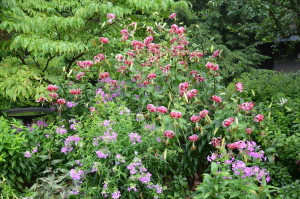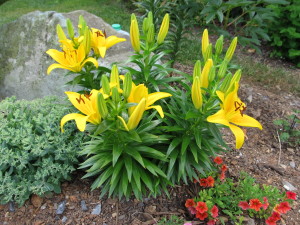Both Asiatic and Oriental lilies (Lilium spp.) are popular lilies in U.S. gardens. Hybrid cultivars share traits of both species. Lilies grow in a wide variety of soil types and are not pH sensitive. They flower in full to part partial sun (5 hours minimum of sunlight). Both prefer a well-drained soil and mulch to keep roots moist and cool.
Both Oriental and Asiatic lilies are top-notch garden performers. Oriental lilies enjoy cooler summer temperatures and are best planted in afternoon shade or all-day dappled sunlight in hotter climates. In mild climate summers, where the average temperature doesn’t usually exceed 90 degrees during July and August, Oriental lilies do equally well in full sun or light shade. No winter mulch is required if your climate is warmer than USDA hardiness zones 6-9.
Flower Fragrance: Asiatic lily flowers have little or no fragrance, and oriental lily flowers are large, exotic (often frilly), and heavily scented.
Cold Hardiness: Asiatics prefer colder winters to reset bloom (zones 1 to 9); Orientals (zones 6 to 9), down to zone 4 (if roots are mulched). Asiatic roots are not heat tolerant. Plants grow shorter and rarely require staking.
Staking: Asiatic lilies grow 1 to 6 feet tall. Oriental lily plants can grow 2-8 feet tall. Although stems are sturdy, Oriental lilies frequently need staking because their heavy trumpet flowers may topple over in windy or rainy weather.
Foliage: Asiatics generally have shiny 4 to 5 inch long leaves clustered close to one another on the stem. The leaf color is typically bright green. Oriental leaves are wider in the middle and longer, spaced further apart on the stem. Leaf color is typically dull green.
Dividing Bulbs: Asiatic lilies tend to double themselves from one year to the next. Oriental lily bulbs also increase in size and increase in bloom count each year. Bulbs should be harvested and divided every 3 to 5 years to prevent over-crowding in the bed.
Varietal Choices: Asiatics offer the widest choices of flower colors and choices from pastels to almost any colors of the rainbow. Asiatics usually come in single colors, while Orientals blooms are white, yellow and pink, with a different color on flower edges.
Bloom Season: Asiatics tend to bloom earlier in late spring. Generally, Orientals start blooming as Asiatic cultivars are finishing up. Mix the two, including hybrids, for a longer show in your garden.



 Posted in
Posted in 
